Many people are unaware of just how many different firearms were produced by the Hotchkiss company over the decades – not many of them received the worldwide acclaim of the more well known arms companies. Hotchkiss was actually founded by an American gunsmith from Connecticut, Benjamin Hotchkiss. Faced with the lack of interest in new arms development in the US during the Civil War, he moved to France and set up a factory (this movement to Europe to find interest in new arms was a common story for American gunmakers at the time). There he proceeded to develop a whole series of pretty successful machine gun designs, including the Hotchkiss Revolving Cannon, Hotchkiss Portative (adopted by the US as the M1909 Benet-Mercie), and the M1914 Hotchkiss heavy machine gun (standard issue for the French Army throughout WWI). This development continued after the end of World War I, and resulted in the M1922 Hotchkiss, a light machine gun made for export to anyone who was interested.
-1024x221.jpg)
The Hotchkiss M1922 was passed over by the French military in favor of the Chatellerault 24/29, and it was not adopted in large numbers by any other major military forces. Several smaller nations did purchase quantities of the gun, and this led to a lot of variations of it being made. Hotchkiss had a long history of exporting weapons, so they knew that flexibility was key to getting small contracts. The M1922 (also referred to as the M1924 and M1926) was available in virtually any rifle caliber a potential client might want, as well as with a variety of barrel types, front grips or handguards, bipods, and even with the option of being fed by strips or box magazines.
Strip Feed
The rigid metal feed strip was obsolete by the 1920s, but not everyone realized this, or cared. It was originally used with the M1914 Hotchkiss heavy MG, and also on the Portative, so it was natural that Hotchkiss would continue to use it. Obsolete or not, it was a proven system that people were familiar with. The short strips would hold 15 rounds, and longer ones held either 24 or 30, depending on the type of cartridge (cartridges like the 8mm Lebel with a rim and large taper were limited to 24 rounds, while more rimless and less tapered ones like the 7mm Mauser would hold 30 in approximately the same length of strip). The strip would be inserted cartridge-side-down into the right side of the gun, and was cycled through the action by an arm connected to the bolt (basically the same mechanism as a belt-fed weapon uses).
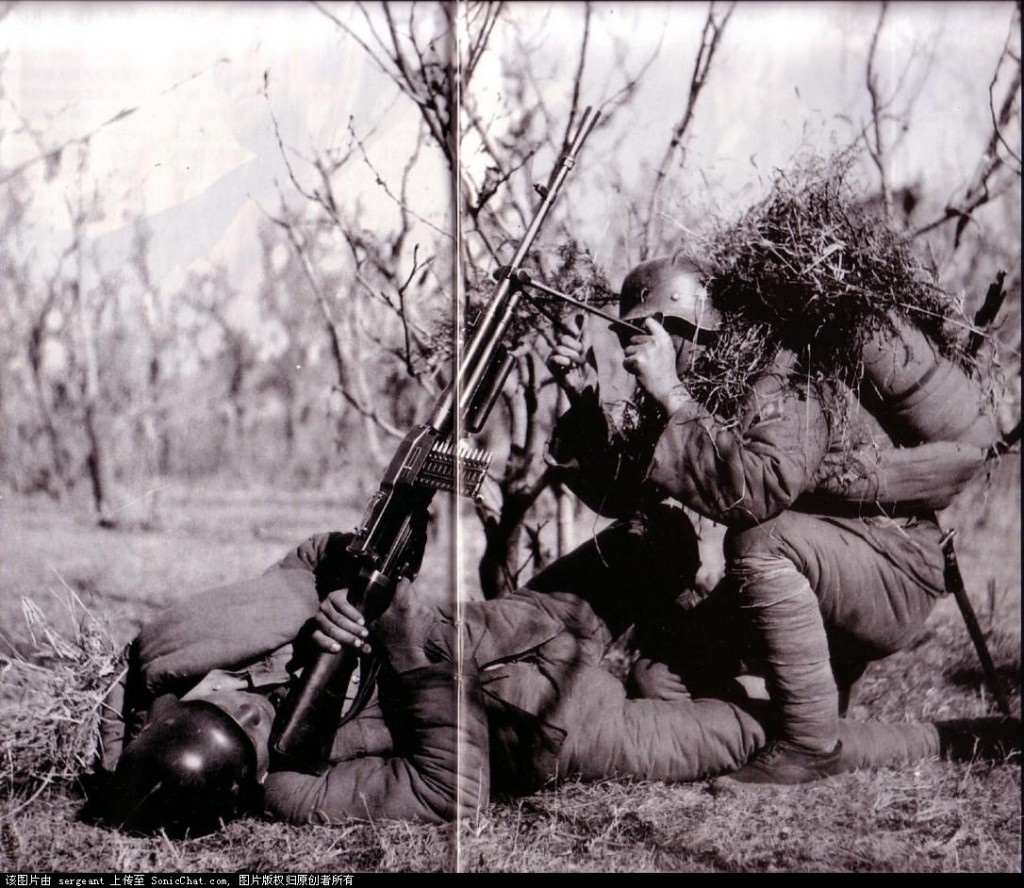
Guns set up for strip feed (which appears to have been the majority of these guns sold by Hotchkiss) has a flip-up top cover like a belt-fed gun, allowing access to the feed mechanism.
We have photos of a strip-fed Hotchkiss M1922 in .303 British that was tested by the UK government in the 1920s (courtesy UK MoD):
[nggallery id=195]
Box Magazine Feed
A more modern and simpler system was to feed a light machine gun such as the Hotchkiss with interchangeable box magazines. While magazines were bulkier and heavier than feed strips, they protected the cartridges from dirt much more effectively, and were generally more durable and less prone to damage than strips. The M1922 could be ordered using box magazines, although we have only found evidence of Spanish and British guns done this way. The receivers were not interchangeable with strip-fed guns, although the basic locking and cycling mechanisms were the same. The box magazine feed dispensed with the need for many of the moving parts in the top cover, and should have made for a cheaper and more reliable gun.
We have photos of a mag-fed Hotchkiss M1922 in .303 British that was tested by the UK government in the 1920s (courtesy UK MoD):
[nggallery id=193]
Heavy Barrels
As mentioned above, the Hotchkiss M1922 could be ordered with several different types of barrel. The most common version was a relatively light profile, sometimes with cooling fins on the rear third or so. The gun was designed as a portable light machine gun, and it was important to keep the overall weight down to a reasonable level. However, there were heavy barrel versions available for use in armored vehicles, antiaircraft emplacements, or other situations where sustained fire would be more important than weight.
Military Purchasers
More than a countries used the M1922 Hotchkiss, although it did not see much service in major wars. Still, it was used in many more local conflicts, and appears to have been a reliable and well-liked gun. Purchasers included:
- Greece – strip-fed in 6.5mm Mannlicher-Schoenauer and 8mm Mauser
- China – strip-fed in 8mm Mauser
- Czechoslovakia – strip-fed in 8mm Mauser
- Spain – mag-fed in 7mm Mauser
- Turkey – strip-fed in 8mm Mauser
- United Kingdom – strip-fed and mag-fed in .303 British
- France (small numbers) – strip-fed in 7.5 French
Thanks to Dimitris from KhakiDepot, we have a handful of photos of Hotchkiss M1922 guns in service with the Greek military (also a couple Turkish guns). We particularly like this one, showing a gun which has been modified with bipod legs from a Breda LMG, and which has an optics mounting bracket on the side of the receiver:
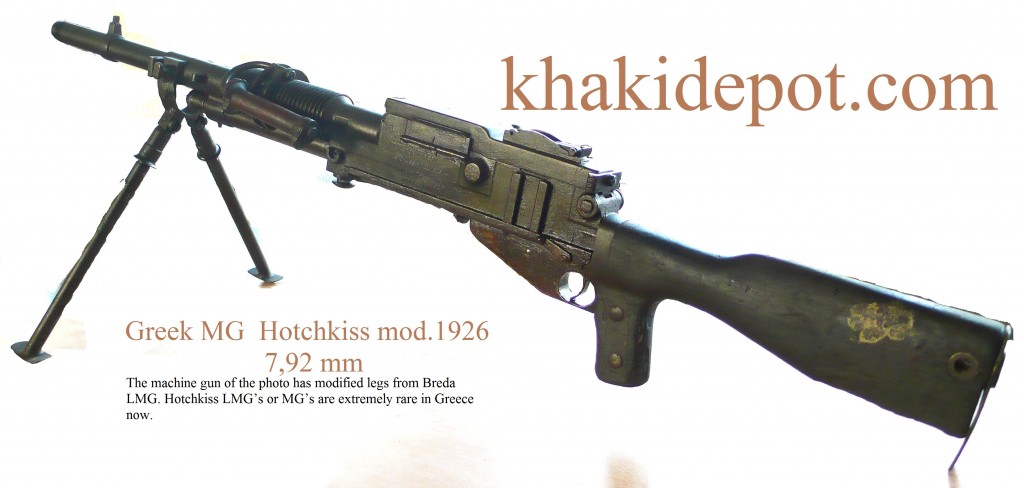
[nggallery id=194]
Mechanism
The 1922 Hotchkiss shares some features of the earlier Portative model, but not all. They both use a fairly large long-stroke gas piston located underneath the barrel to operate, but the Portative used a rotary locking mechanism, while the 1922 model has a bolt which tilts up to lock into the receiver. A swinging link connects it to the gas piston, pulling it down and out of battery when the gun is fired (something like the operating principle of the BAR).
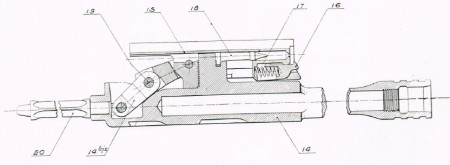
The trigger mechanism was full-auto only, with no setting for single shots. It did include a rate reducing mechanism, though, and a selector lever allowing the shooter to choose the fast or slow rate of fire. The wheel in the diagram below rotates against a spring, and acts to reduce the cyclic rate when engaged.
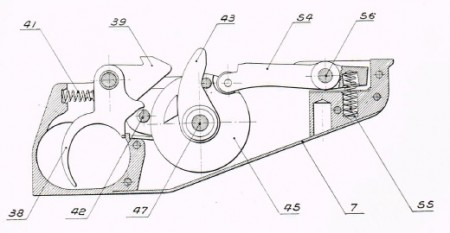
Manuals
We have a French manual for the strip-fed version of the M1922, as well as a few other documents pertaining to the gun:
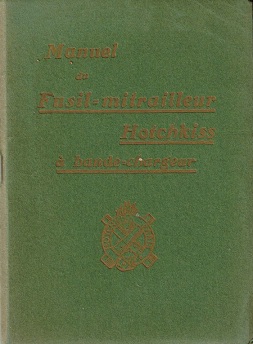
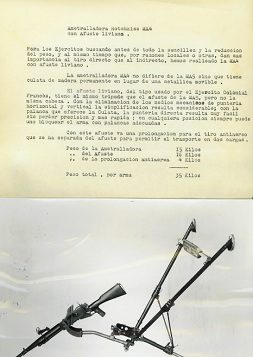
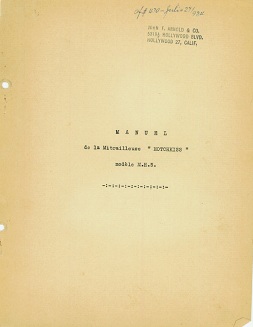
Additional Photos
Here are photos of two other Turkish M1922 guns that were deactivated and sold by Armas Izzara (I downloaded copies of the photos, and if the links do dead I’ll upload them here myself):


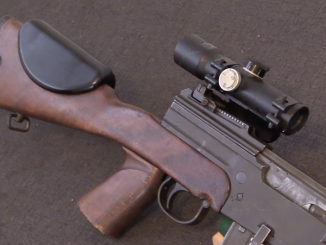
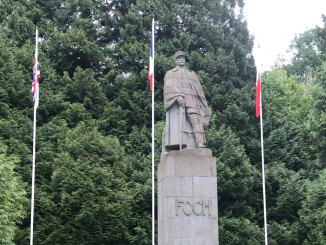
Thanks Ian! You’ve done it again!
I have to ask Dmitris or other folks more familiar with Greece/The Balkan peninsula and its history:
In the first image, given that the operator is a woman with her hair pulled back under her military cap, and the other firearm appears to be a Mosscheto M91 or M38 Carcano captured from the Italian army, are those ELAS or EAM partisans rather than the GNA?
Very interesting and informative. Great info.
Excellent piece, Ian! Thanks for posting. The Hotchkiss LMG are forgotten weapons, despite the fact that they got used on a worldwide basis, from South America to the Middle East. In Spain, the M 1922 was so well liked that its purchase spurred local, licenced production at the state-owned arsenal in Oviedo as the FA (Fusil Ametrallador) M 1922/25 7mm. Eventually, during the Civil War the Nationalist directorate that took care of weapons and munitions production set up a new arsenal at La Coruña, with machinery and personnel inherited from the old one that worked at Oviedo until the beggining of the Civil War (btw, Oviedo was almost instantly taken by rebels, as the local garrison, led by the colonel Antonio Aranda, immediately sided with Franco and Mola), mainly because the Asturian capital remained practically on the front and by the Republican-held major part of Asturias till the Nationalist offensive of September/October 1937 managed to conquer the last loyalist redoubt in the North. After the production was relocated to La Coruña, the new management developed a new derivative of the locally-made Hotchkiss M 1922/25, the F.A. OC (Fusil Ametrallador Oviedo-Coruña) – sometimes also designated F.A. Oviedo-Coruña M 1925/1938 – a somewhat simplifed, magazine fed version of the former, which I think was the last member of the Hotchkiss LMG family to reach production status (as of early 1940, it was still being made, when Oviedo started to churn out their own LMG, a reverse engineered, unlicenced copy of the ZB-30).
Interesting article
Firing a machine gun with your shoulder against the ground? That looks painful.
I’m not sure the Hotchkiss 1922 were ever ‘used’ in Czechoslovakia (meaning “service issued weapons”), but they were tested there, along M1922 BAR (both are on display in the Czech Army Museum in Prague) but pitted against the ZB-26, these were rather defenseless – not because they were particularly lacking, but the Holek LMG was just that much better 🙂
So, if you list not only users, but perusers, you might as well add Poland – the stripper Hotchkiss was a contender in Polish LMG contest, won by the BAR. Or, rather, a BAR knock-off, combining R75 Colt Monitor mechanics with stock-relocated return spring and pistol grip, with bipod and several local idiosynchrasies. I’m sending a photo from Polish trials to Ian, maybe he’ll add it to the galery.
Hi Leszek
I did some search in Czech sources and found that Hotchkiss Mle 1922/26 was indeed used as an interim weapon there being ordered in limited quantity of 1000pcs and introduced to Czechoslovak army as vz.24. There was also in that period in use limited amount of Darne and Madsen LMGs. The history of early search for and testing of LMGs for Czech military was rather complex and hectic. There were lots of political and business related influences.
The new Czech designed machinegun known as vz.26 (designed originally by Praga arms factory) was introduced shortly afterwards. It supplanted all previously fielded systems as Zbrojovka Brno started to fill the order. Mr.Holek was original designer while still under ownership of Praga moved later with purchase of license by ZB to Brno. The design team was eventually led by Mr.Jelen who’s effort culminated by vz.30 and eventually the Bren.
OK, my bad – I have since checked and found out what you have just wrote here. As a matter of fact, I came over to this thread to correct myself 🙂
And the ZB-26 history is going in circles indeed – it started at Praga as the belt-fed gun (the I-23), then converted to magazine feed (vz.24), then went over to Zbrojovka in Brno and became the ZB-24, then proceeded through a series of modifications and culminated in the ZB-26. And it was not a success-from-the-start story, it really took a LOT of tinkering to come out to a straight and narrow.
Interesting that the British trial mag was a solid side mag where all of the production 1922 mags had a open slot running the length of both sides to show round count. I guess the British learned the Chauchat lesson of exposed rounds, but the French never did.
Kuhn in his “revolutions in science” said that paradigms only change when the old guard die out or are replaced by youngsters holding the new beliefs.
Perhaps the same bureaucrat responsible for the open slot on the Chauchat mag was still in position.
+1 for the Thomas Kuhn reference, even if I strongly disagree with his thesis. (It is far too post-modern for my sensibilities).
Sharp eye Dave,
yes the first photo was taken in 1944 in the Agrafa mountains, were operate the
ELAS ( Ellinikos Laikos Apeleftherotikos Stratos )- Greek Pooular Liberation Army,
Reserve Officers School.The students of this school (men-women) were selected for
their performance in battles against the Italians and Germans.
Información muy interesante Aballe. En algún lugar tengo fotos de los Republicanos
utilizar Hotchkiss, pero no sabía que existía en España.Pensé que había adquirido
ilegalmente para los franceses.
Vaya, Dimitris, tu español es muy bueno… Enhorabuena por tu dominio del idioma. Por cierto, la ametralladora Hotchkiss pesada también se fabricó en España (bajo la denominación reglamentaria de Modelo 1914, en 7mm por supuesto), pero eso seguro que ya lo sabias. La República importó el mismo modelo – desde Francia, según tengo entendido – en otros calibres, notamente en 8mm Lebel.
Well, to those who cannot read the language of Cervantes, I was just complimenting Dimitris for his very good grasp of it. Also mentioned the fact that the heavy Hotchkiss M 1914 was also built under licence by the Spanish arsenals (they actually did so until the eve of the Civil War). Additional Hotchkiss ‘heavies’ were obtained by the Republicans from French sources during the war, but most were chambered for the 8mm Lebel. The Mexican government of Lázaro Cárdenas is also rumoured to have sent some (in 7mm Mauser) from their own stocks.
Gracias por la información.
En general, confundir italianos con español..ja,ja.ja!!!!
En el Museo de la Akademia Militar es un rifle Mauser hecho en la Coruña en 1948.
No sé cómo fue en Grecia.
Hombre, de nada, fue un placer. Respecto al Mauser español,¿Hablas en serio? No tengo ni idea de como haya ido a parar a Grecia, máxime tratándose de um modelo tardío (en realidad una copia del vz.24 checo)… ¿Qué tal está el museo de la Academía Militar? ¿Hay armas raras?… Me gustaría ver una foto del mítico prototipo del fusil automático EPK (Pyrkal)… jejeje..
Hombre,
Lo siento por el retraso, pero busco para encontrar la foto del rifle de Coruña. El Museo de la Academia Militar se encuentra en Atenas y cuenta con una interesante colección de armas (sobre todo el período de transición a principios de los fusiles de avancarga a retrocarga, el famoso fusil Milonas mle.1872 de 11mm, algunas experimental fusiles auto-cargades Grass de 8mm, el muy raro [me parece que el único construido] fusil Lelahis de 6,5mm ..etcétera..). El más raro de todos es el rifle Arnaud de fortificación a retrocarga mle.1819 hecho único en Francia y se utiliza en la Revolución Griega de 1821.El Museo non está abierto al público, pero si alguna vez se encuentra el camino a Atenas estaré encantado de organizar un pase para usted.
Mi PC tiene un problema (y el operador), pero espero que yo pueda enviar la foto.
La única foto de la EPK es el vínculo que se envió Big Al.
Sorry boys, the translation
The Museum of the Military Academy is located in Athens and has an interesting collection of weapons (especially the transition period in the early muzzle loading rifles to breech loading, like the famous Milonas rifle mle.1872 in 11mm, some experimental self loaders Grass in 8mm, the very rare Lelahis rifle in 6.5 mm .. etc. ..). The rarest of all is the Arnaud fortification breechloading rifle mle.1819, only one made in France and is used in the Greek Revolution of 1821.) The Museum is not open to the public.
When I was a kid (born 1949) the Borough Hall of Fort Lee, NJ had two Hotchkiss M1914 MGs set up on the front lawn…they were painted
battleship grey’ but at the time I ha no idea (or interest in) their history, significance or provenance…I moved away from there over 60 years ago – 1961 – and don’t know the fate of them…from what I unbderstand, they’re no longer there – it figures, what with NJ turning into a “People’s Demokratik Republik”.
CB in FL
Considering the mess that Rick Scott has made of the Florida University System, I don’t think you’re really not in a place to complain, Chris.
Have you considered that maybe they SIMPLY RUSTED?
(By the way, last I checked the state of New Jersey was run by conservative Republicans.)
Pardon the double negative. Damned phone screen didn’t show that I had already written ‘don’t.’
Dimitris & Ian :
Per our discussions on the “Vintage Saturday : Too Sexy For My Shirt” post concerning the Hotchkiss Mle 1922 — Many, many thanks for this great follow-up!
Giasou Dimitri! Great posts! I also really like your website. Do you ship to the US?
Thank you Big Al,
I am glad that you liked our website.
We ship to America. Do you have any connection
with Greece?
Do I have a connection to Greece, you ask? I am Greek, both sides of my family. My grandfather from my father’s side was born in Aidonoxori. Later, he moved to Thessaloniki and got involved in the family construction business. It grew to become one of the biggest contractors in Northern Greece in the ’30s. When war came, he joined the army and fought the Italians and the Germans.
I have heard some stories from my father from that era, but I do not know what unit he served in or at what rank. I assume he made the rank of sergeant because my family has a photo of him holding a Thompson (typically an NCO weapon, I believe; can’t find the photo now, it is buried in a bag somewhere).
One story I love to hear is how he saved his squad from starvation. One day he was out walking and found an unexploded grenade. He hid it under his coat and made his way back to camp. The squad was camped by a river and they had not eaten much in days. My grandfather was walking past the river and saw it was full of fish. When no one was looking, he chucked the grenade into the water, blowing the fish onto the bank. Everyone was overjoyed and was likening it to “The Feeding of 5,000” from the bible.
Shortly after the fish were gathered up and cooking, a furious officer came around to find out who used his grenade without orders. My grandfather was safe because he still had his 2 issued grenades.
Giasou patrioti,
When you say that your grandfather had Thompson, what do you mean;
Your grandfather in witch front had foughtn, the Albanian front or in the Metaxas Line?
The British were sent in 1941 about 900 Thompson’s but it is not known where endet up.
During the war in the Albanian front has never heard something about Thompson.
Did your grandfather had fought in the Civil War?
In the Greek army of the era 1940-41 ,a SMG Thompson was not an NCO weapon. The SMG’s
were unknown. Only the Gendarmerie had some MP-34 special made for Greece in 9mm Mauser.
If your grandfather was in Albania or in Metaxas Line holding a Thompson, WE WANT THIS PHOTO !!!!!!!!!!!!!!
Very well then! I must find that photo. I’ll contact you when I find it.
For R.(Ricardo?) Aballe:
I enjoyd your chat with Dimitris… this is international gathering after all. I picked up some Spanish but not as much as Dimitris. I want to say how I appreciate the knowledge of arms production in Spain you are presenting. I am myself great admirer of gun manufacture activities by Spaniards, namely in pistols. One of my cousins bought some years ago Astra revolver in .357Mag; a solid piece of ordnance.
Thanks Denny! Unfortunately, the Spanish gun industry, with its long and proud history, is now a thing of the past… Famous names such as Astra, Star or Llama are nothing but a memory of times gone by.
Your comment on the .357 Mag Astra bought by your relative is interesting. Did you fire it? The Astra revolvers were well made. As far as I know, most of the production was exported abroad (the smaller bore models in .22 and .32 were quite popular in their home country though), mostly to the US and Latin American nations. Today, new old stock Cadix revolvers can still be found in dwindling numbers, which is not surprising having in mind the fact that the last examples were manufactured in the mid 90s (the original company, Astra, Unceta y Cía., disappeared after merging with Star, actually a last ditch attempt to keep the Basque handgun industry afloat; the whole affair didn’t work and Astra was finally and officially liquidated in 1999).
Returning to the Spanish LMGs subject, I should have mentioned two other local developments, meant as autarchic answers to (and eventually to replace) the Hotchkiss M 1922/25 in Spanish service: the F.A. Astra-Unión Modelo 1927, designed as a private venture by an independent engineer who sold his idea to Astra, who produced it in very small numbers (perhaps just for trial purposes) by the late 20s/early 30s.
The onset of the depression and the proclamation of the Republic on April 14, 1931, are two factors that may help explain why the M 1927 never managed to replace the Hotchkiss designs. The other reason lies in the fact that the government preferred to rely upon a design manufactured by the newly formed Consorcio de Industrias Militares, basically a conglomerate of all state-owned armament industries. The selection of the M 1927 was thus annulated, and a new, locally designed LMG was selected for adoption by the Spanish Army, the F.A. Trapote Modelo 1933. It was developed by an artillery officer named Andrés Trapote and made at the Oviedo arsenal (just a few hundreds). Despite all the trouble, the new Trapote M 1933 must have suffered from more than the usual share of issues, for by 1936 the Spanish army was again looking for a suitable modern LMG, in order to complement and eventually replace the aging M 1922s…
Btw, to the list of M 1922 users provided by Ian I should add the following countries:
Brazil – strip-fed in 7mm Mauser
Peru – strip-fed in 7.65mm Argentine
Portugal – strip-fed in .303 British (for the G.N.R., a local gendarmerie force, similar to Spain’s Guardia Civil); note: I have an interesting photo taken during a coup attempt (against the military dictatorship then in charge) in 1931, showing one of the rarely seen Portuguese Hotchkiss M 1922.
I had no idea that the entire Basque firearms industry was dead.
A damned shame.
Yes, now we have only the memories, surviving guns, some archives and a few buildings. Reg. the later, the folks that study and preserve the industrial heritage have been lobbying local politicians and businessmen to avoid demolition of the best examples from an architectural/heritage point of view. Unfortunately, sometimes things can go very, very wrong: a few weeks ago I learned, much to my dismay, that the historically and architecturally very significant old Hispano-Suiza facilities in Guadalajara have been demolished…
Ruy, I am terribly sorry to hear about the loss of the Hispano-Suiza factories. I can only imagine how you must have felt. Didn’t the politicians and businessmen even stop to consider that their own family heritages may have been linked, directly or indirectly like most of the nation, to HS? While I understand that the old must eventually make way for the new, at the very least the more important parts of the former must be preserved for the sake of historical and social continuity, for we are all part of what has come to pass as well as part of what now exists. And, future generations need to learn about the whys and wherefores of their history and heritage.
I don’t like to judge, but it seems very short-sighted for the parties involved to have allowed this to happen. One can see this sort of thing happening all the time all over the world, where the things that really matter in the long run — health, well-being, environment, heritage, history, equity, respect, a balanced society, et al., — are largely sacrificed for short-term monetary gain.
Well, MOST of the Basque gun industry has gone, but there is a ray of light in this darkness, a company called Bergara from – well, you might have guessed, Bergara in Euzkadi. They are making excellent bbls and after a period of one-shot Apex hunting rifles they are now making a very good and novel modular repeater, the BX11, which I had the opportunity to test for my gun magazine here in Poland. A LONG shot away from Cebra pistols, fortunately.
Oh, BTW – anyone has detailed photos of the locked-breech Ruby .45 ACP of 1920s, broadsides and a stripped view? It seems that they have pioneered the solid barrel unlocking lug, as used in both FN GR/HP and Radom Vis pistols… I need these for my (ever)coming book on Radoms. If you do, please PM me at: leer@magnum-x.pl
Leszek, I might have some clues that might be of interest, but will ask around about it first. Please give me a few days. I will contact you as soon as I get a solid answer from a very knowledgeable person.
And yes, Bergara is a very interesting company, quite unlike anything seen before in the Basque country if you ask me. They started as barrel manufacturers and that remains their core activity today. I found the aesthetics of their rifles’ stocks a bit questionable, but that is just a matter of (my own) personal taste; the overall product is innovative and, as you wrote, very good indeed.
No, I did not have chance to fire it, just inspected it. My cousin wanted more powerful gun than domestically made CZ pistol.
Still, regarding the Spanish/ Basque gun tradition – as far as pistol type weapons although largely derived from Browning style design, they had always some unique take on them. I have saved front page from catalogue on latest Astra pistol line.
As far as Spain and Austrian Empire being traditionally allies, was there any commonality in their armaments in the past? It is conceivable that arms such as Hotchkiss would find acceptance in Spain because of France’s proximity.
I see. Thanks for your answer. The revolver bought by your cousin must have come from the latest batches produced by Astra, or maybe it was just a re-circulated, new old stock gun made in the 80s (they completely cleared the factory warehouse back in the 90s).
I agree with you on Spanish/Basque pistol design idiosyncrasies.
Regarding your last question, well, that may have worked back in the old days of Charles V, Holy Roman Emperor and King of Spain, and of his son, Philip II… but not so much in later centuries. Well, just kidding. As you know, Spain entered the smokeless era in small arms with the adoption of the Mauser M 1893 (with a few M 1891 carbines bought slightly before) and the 7×57 round. That fact alone inaugurated a long relationship with the German arms manufacturing school of thought.
Such “German imprint” subsisted for many years, well into the first two decades of Franco’s regime, alongside a drive for indigenous developments that left many “what ifs” on its path over the years (not just small arms, but also armored vehicles, light tanks and even aircraft – some never got past the paper or, at best, the prototype stage). A good example is the MR 32 self-loading rifle in 7mm Mauser developed in the early 30s by a group of technicians working at Oviedo. The gun was tested by the Spanish Army, who found it to be a good performer to the point of warranting the arsenal a much coveted clearance to propose it for export, as it was demonstrated before a Portuguese delegation that visited the small arms section of the Trubia complex in 1934. The Portuguese officers marveled at the gun, but also considered – much like their conservative Spanish colleagues, I guess – it to be a potential ammo “waster” and too fancy and expensive a rifle to be handed over to illiterate peasant conscripts… And the gun was duly forgotten afterwards, the whole project being shelved. As a matter of fact, the Spanish army never fielded a semi-auto rifle and made (like its Portuguese counterparts) a direct transition from bolt action Mausers to modern select fire battle rifles.
All is in vanity and changing fortunes my friend, isn’t it. Thanks to your explanation as to how Spain picked up the German arms tradition… now it all adds up.
That gun, Astra actually, I certainly wished to fire, however timing of my visit did not favour to it. As you say, it must have been one of last series; it came out probably less expensive than comparable American made product. The finish was not flashy, but like was said, it made good impression on me. I fired previously .357Mag so I know this caliber means business.
Yes, that’s true! And you are welcome. As for the Astra revolver of your cousin, and still regarding its finish, I think such handguns were less expensive than US-made revolvers (and much less than Manurhin MR73), but their finish and quality control were certainly above Brazilian-made revolvers from the same era…
I’m not 100 per cent sure but in photo no4 we see cadets of Sholi Evelpidon – Σχολη Ευελπιδων, (which is the army officers school) in Crete in 1941.Also as a sidenote Hotchkiss M 1922 was used as the base for an experimental selective fire rifle using a proprietary intermediate cartridge just before WW2 began. I believe i have sent you a photo of this weapon a couple of years ago Ian, only i can’t find it again now.
Γειά σου Κώστα,
όντως στην φωτ. 4 εικονίζονται μαθητές της ΣΣΕ το 1938.
Η φωτ. προέρχεται απο ένα προπαγανδιστικό έντυπο του
Υφυπουργείου Τύπου και Τουρισμού με τίτλο Ο Εθνικός
Στρατός της σήμερον 1936-1940,έκδοση του 1940.
And for those who cannot read the language of Aeschylus….indeed the photograph no.4 depicted students from the army officers school in 1938.
The photograph comes from a propaganda book of the Metaxas regime,
publised in 1940 by the Undersecretary’s Office of the Press and Tourism entitled The National
Army of today 1936-1940.
I believe this is it, Kosta. The EPK Machine Gun: http://en.wikipedia.org/wiki/EPK_%28Pyrkal%29_Machine_gun
Hi, Big Al :
I read the link you provided with great interest — an innovative “Ultimax 100”-type weapon long before there was an Ultimax 100. Thanks for sharing it!
The 7.92mm x 36 EPK cartridge made for the gun was, I assume, a shortened or “Kurz” version of the contemporary 7.92mm x 57 Mauser cartridge. On that basis, the quoted muzzle velocity of 823 m/sec. ( 2700 ft/sec. ) seems high, especially since the full-sized 7.92mm x 57 round typically had a muzzle velocity of 755 m/sec. ( 2475 ft/sec. ) when fired from the standard 552mm ( 21.75″ ) barrel of the MG-42 GPMG.
If the EPK round actually did achieve that level of ballistic performance, the bullet must have been much smaller and lighter, everything else being equal — or is the figure in the Wikipedia article a misprint?
I have same feel, Earl.
It may be out of order (in Wikipedia), e.i. lesser volume cartridge with higher velocity. In any case, they certainly had some real innovative thoughts.
My grandfather was conscripted in the Greek army and fought the Italians at Pindus. He didn’t speak much about it, and sadly died a long time ago. I do at least have a couple of stories and a picture.
What weapons did the Greeks use in Albania? I know they had the M1930 Mauser and M1903/14 Mannlicher-Shoenauer rifles, were they just handed out or did the Greeks assign all the same rifles to units? Did they use a lot of the Hotchkiss M1922, and what othe MG’s did they have? Also were the uniforms/gear consistently new or was old stuff used like Adrian helmets? The picture I have shows my grandfather in the newer greatcoat and garrison cap like khakidepot.com.
I agree with Cavalier’s comment ( May 24, 2013 @ 9:51 a.m. ). That is an unusual improvised position to use for low-level AA defence. The more common method is to have the AG support the gun across his shoulders while in a crouched or semi-crouched position, leaving the gunner in a kneeling position with better control and flexibility to track an aerial target. Either way, it’s a very loud and uncomfortable position for the poor AG.
@ Leszek Erenfeicht / May 27, 2013 at 9:48 a.m. :
Bergara has been selling precision barrel blanks and complete barrels here in the United States for a while. They cater mostly to custom gun builders, gunsmiths and restoration specialists who demand a precisely-made, high-quality barrel blank or barrel as a starting point for target shooting and hunting. The quality is extremely good by any standards, yet the price is incredibly reasonable for what you are getting. Many of the larger firearms accessories distributors have them in stock or available on order. As an example, check out http://www.thesportsmansguide.com and enter Item Code # A3A-227866 ( .30-cal. barrel blank ) or Item Code # A3A-225982 ( Bergara T/C 300 AAC Encore Blackout Barrel ). They are works of art with a real-life utilitarian purpose.
Everything is very open with a precise explanation of the challenges.
It was truly informative. Your site is useful.
Many thanks for sharing!
You will not even get lost in seeking the right cool
shoes because most with the items displayed in categories.
Caroline Davidson would have been a student at Portland State University
where she met Phil Knight. With the emergence of Nike and shoes such as the Air Jordan’s and
Nike Air Force Ones, sneakers took over as footwear of choice for teens, children and the younger generation throughout the world.
As I website owner I believe the subject matter here is rattling wonderful, regards
for your efforts.